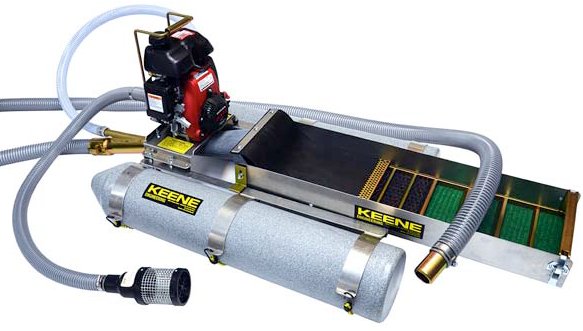
One of the best tools that a modern day prospector can use to find gold today is the suction dredge. Not to be confused with the bucket line dredges of the old days, suction dredges offer the modern day gold prospector the ability to process a lot of material very quickly.
They essentially work as an underwater vacuum cleaner, sucking up gravels from the streambed and moving them through a sluice box mounted between two pontoons floating on the surface of the water. A pump is attached to the unit, creating suction in a hose which bring material up from the streambed and into the sluice. The gravel works through the sluice box, discharging lighter materials out the back of the sluice, while retaining the heavier concentrates.
Dredges come in many different sizes. The diameter of the suction hose is what is used to rate the size of the dredge, but the tip should actually be slightly smaller. This will help reduce the rocks and other materials from getting jammed up in the suction hose. Also be aware that most manufacturers rate the size of their dredges based on the diameter of the hose, while often the regulations in various states are based on the size of the suction nozzle. The most common dredge sizes are between 2” and 6”.
The benefits of smaller dredges are that they are much easier to maneuver, and they will use less gas to operate. Obviously the smaller dredges will not be able to process as much material as a larger dredge, so it is generally a good idea to use the largest size dredge that is legal in your area to get the most gold for your time invested.
The biggest disadvantage of the larger suction dredges is that they can be more difficult to handle. Moving around a large hose full of gravel can be a real chore, and really wear out a dredge operator after a long day. Still, if you want to recover as much gold as you possibly can a bigger unit will probably be worth that extra work.
Sometimes dredges are used in low water conditions and don’t require a wetsuit, but generally a dredger will be setup with a snorkel and wetsuit so they can work the deeper areas.
Obviously, it would be quite inefficient to need to come up for air every minute, so a hookah air system is also commonly used. This allows the dredger to work uninterrupted for a long period of time by supplying a constant supply of air from the surface to the dredger.
Gold dredges are a large piece of mining equipment and generally costing several thousand dollars. This is certainly a significant investment, much more costly than a gold pan or sluice box, but the advantage of moving a lot of material is a huge benefit to the gold miner.
If you find a good paystreak, you can easily recoup the cost of your dredge and make a good profit mining for gold with a little luck and a lot of hard work.

